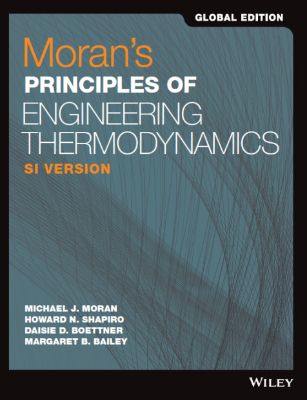Moran's Principle of Engineering Thermodynamics SI Global Edition

Námskeið
- VT VAR1013 Varmafræði I
Lýsing:
p> Moran’s Principles of Engineering Thermodynamics, SI Version , continues to offer a comprehensive and rigorous treatment of classical thermodynamics, while retaining an engineering perspective. With concise, applications-oriented discussion of topics and self-test problems, this book encourages students to monitor their own learning. This classic text provides a solid foundation for subsequent studies in fields such as fluid mechanics, heat transfer and statistical thermodynamics, and prepares students to effectively apply thermodynamics in the practice of engineering.
This edition is revised with additional examples and end-of-chapter problems to increase student comprehension. Moran’s Principles of Engineering Thermodynamics, SI Version , continues to offer a comprehensive and rigorous treatment of classical thermodynamics, while retaining an engineering perspective. With concise, applications-oriented discussion of topics and self-test problems, this book encourages students to monitor their own learning.
Annað
- Höfundar: Michael J. Moran, Howard N. Shapiro, Daisie D. Boettner, Margaret B. Bailey
- Útgáfa:9
- Útgáfudagur: 2018-11-02
- Hægt að prenta út 10 bls.
- Hægt að afrita 2 bls.
- Format:ePub
- ISBN 13: 9781119455851
- Print ISBN: 9781119454069
- ISBN 10: 1119455855
Efnisyfirlit
- Cover
- Title Page
- Copyright
- Preface
- Acknowledgments
- Contents
- Chapter 1 Getting Started: Introductory Concepts and Definitions
- 1.1 Using Thermodynamics
- 1.2 Defining Systems
- 1.3 Describing Systems and Their Behavior
- 1.4 Measuring Mass, Length, Time, and Force
- 1.5 Specific Volume
- 1.6 Pressure
- 1.7 Temperature
- 1.8 Engineering Design and Analysis
- 1.9 Methodology for Solving Thermodynamics Problems
- Chapter Summary and Study Guide
- Chapter 2 Energy and the First Law of Thermodynamics
- 2.1 Reviewing Mechanical Concepts of Energy
- 2.2 Broadening Our Understanding of Work
- 2.3 Broadening Our Understanding of Energy
- 2.4 Energy Transfer by Heat
- 2.5 Energy Accounting: Energy Balance for Closed Systems
- 2.6 Energy Analysis of Cycles
- 2.7 Energy Storage
- Chapter Summary and Study Guide
- Chapter 3 Evaluating Properties
- 3.1 Getting Started
- 3.2 p–υ–T Relation
- 3.3 Studying Phase Change
- 3.4 Retrieving Thermodynamic Properties
- 3.5 Evaluating Pressure, Specific Volume, and Temperature
- 3.6 Evaluating Specific Internal Energy and Enthalpy
- 3.7 Evaluating Properties Using Computer Software
- 3.8 Applying the Energy Balance Using Property Tables and Software
- 3.9 Introducing Specific Heats cυ and cp
- 3.10 Evaluating Properties of Liquids and Solids
- 3.11 Generalized Compressibility Chart
- 3.12 Introducing the Ideal Gas Model
- 3.13 Internal Energy, Enthalpy, and Specific Heats of Ideal Gases
- 3.14 Applying the Energy Balance Using Ideal Gas Tables, Constant Specific Heats, and Software
- 3.15 Polytropic Process Relations
- Chapter Summary and Study Guide
- Chapter 4 Control Volume Analysis Using Energy
- 4.1 Conservation of Mass for a Control Volume
- 4.2 Forms of the Mass Rate Balance
- 4.3 Applications of the Mass Rate Balance
- 4.4 Conservation of Energy for a Control Volume
- 4.5 Analyzing Control Volumes at Steady State
- 4.6 Nozzles and Diffusers
- 4.7 Turbines
- 4.8 Compressors and Pumps
- 4.9 Heat Exchangers
- 4.10 Throttling Devices
- 4.11 System Integration
- 4.12 Transient Analysis
- Chapter Summary and Study Guide
- Chapter 5 The Second Law of Thermodynamics
- 5.1 Introducing the Second Law
- 5.2 Statements of the Second Law
- 5.3 Irreversible and Reversible Processes
- 5.4 Interpreting the Kelvin–Planck Statement
- 5.5 Applying the Second Law to Thermodynamic Cycles
- 5.6 Second Law Aspects of Power Cycles Interacting with Two Reservoirs
- 5.7 Second Law Aspects of Refrigeration and Heat Pump Cycles Interacting with Two Reservoirs
- 5.8 The Kelvin and International Temperature Scales
- 5.9 Maximum Performance Measures for Cycles Operating between Two Reservoirs
- 5.10 Carnot Cycle
- 5.11 Clausius Inequality
- Chapter Summary and Study Guide
- Chapter 6 Using Entropy
- 6.1 Entropy–A System Property
- 6.2 Retrieving Entropy Data
- 6.3 Introducing the T dS Equations
- 6.4 Entropy Change of an Incompressible Substance
- 6.5 Entropy Change of an Ideal Gas
- 6.6 Entropy Change in Internally Reversible Processes of Closed Systems
- 6.7 Entropy Balance for Closed Systems
- 6.8 Directionality of Processes
- 6.9 Entropy Rate Balance for Control Volumes
- 6.10 Rate Balances for Control Volumes at Steady State
- 6.11 Isentropic Processes
- 6.12 Isentropic Efficiencies of Turbines, Nozzles, Compressors, and Pumps
- 6.13 Heat Transfer and Work in Internally Reversible, Steady‐State Flow Processes
- Chapter Summary and Study Guide
- Chapter 7 Exergy Analysis
- 7.1 Introducing Exergy
- 7.2 Conceptualizing Exergy
- 7.3 Exergy of a System
- 7.4 Closed System Exergy Balance
- 7.5 Exergy Rate Balance for Control Volumes at Steady State
- 7.6 Exergetic (Second Law) Efficiency
- 7.7 Thermoeconomics
- Chapter Summary and Study Guide
- Chapter 8 Vapor Power Systems
- 8.1 Introducing Vapor Power Plants
- 8.2 The Rankine Cycle
- 8.3 Improving Performance—Superheat, Reheat, and Supercritical
- 8.4 Improving Performance—Regenerative Vapor Power Cycle
- 8.5 Other Vapor Power Cycle Aspects
- 8.6 Case Study: Exergy Accounting of a Vapor Power Plant
- Chapter Summary and Study Guide
- Chapter 9 Gas Power Systems
- 9.1 Introducing Engine Terminology
- 9.2 Air-Standard Otto Cycle
- 9.3 Air-Standard Diesel Cycle
- 9.4 Air-Standard Dual Cycle
- 9.5 Modeling Gas Turbine Power Plants
- 9.6 Air-Standard Brayton Cycle
- 9.7 Regenerative Gas Turbines
- 9.8 Regenerative Gas Turbines with Reheat and Intercooling
- 9.9 Gas Turbine–Based Combined Cycles
- 9.10 Integrated Gasification Combined-Cycle Power Plants
- 9.11 Gas Turbines for Aircraft Propulsion
- 9.12 Compressible Flow Preliminaries
- 9.13 Analyzing One-Dimensional Steady Flow in Nozzles and Diffusers
- 9.14 Flow in Nozzles and Diffusers of Ideal Gases with Constant Specific Heats
- Chapter Summary and Study Guide
- Chapter 10 Refrigeration and Heat Pump Systems
- 10.1 Vapor Refrigeration Systems
- 10.2 Analyzing Vapor-Compression Refrigeration Systems
- 10.3 Selecting Refrigerants
- 10.4 Other Vapor-Compression Applications
- 10.5 Absorption Refrigeration
- 10.6 Heat Pump Systems
- 10.7 Gas Refrigeration Systems
- Chapter Summary and Study Guide
- Chapter 11 Thermodynamic Relations
- 11.1 Using Equations of State
- 11.2 Important Mathematical Relations
- 11.3 Developing Property Relations
- 11.4 Evaluating Changes in Entropy, Internal Energy, and Enthalpy
- 11.5 Other Thermodynamic Relations
- 11.6 Constructing Tables of Thermodynamic Properties
- 11.7 Generalized Charts for Enthalpy and Entropy
- 11.8 p–v–T Relations for Gas Mixtures
- 11.9 Analyzing Multicomponent Systems
- Chapter Summary and Study Guide
- Chapter 12 Ideal Gas Mixture and Psychrometric Applications
- 12.1 Describing Mixture Composition
- 12.2 Relating p, V, and T for Ideal Gas Mixtures
- 12.3 Evaluating U, H, S, and Specific Heats
- 12.4 Analyzing Systems Involving Mixtures
- 12.5 Introducing Psychrometric Principles
- 12.6 Psychrometers: Measuring the Wet-Bulb and Dry-Bulb Temperatures
- 12.7 Psychrometric Charts
- 12.8 Analyzing Air-Conditioning Processes
- 12.9 Cooling Towers
- 12.9 Cooling Towers
- Chapter 13 Reacting Mixtures and Combustion
- 13.1 Introducing Combustion
- 13.2 Conservation of Energy—Reacting Systems
- 13.3 Determining the Adiabatic Flame Temperature
- 13.4 Fuel Cells
- 13.5 Absolute Entropy and the Third Law of Thermodynamics
- 13.6 Conceptualizing Chemical Exergy
- 13.7 Standard Chemical Exergy
- 13.8 Applying Total Exergy
- Chapter Summary and Study Guide
- Chapter 14 Chemical and Phase Equilibrium
- 14.1 Introducing Equilibrium Criteria
- 14.2 Equation of Reaction Equilibrium
- 14.3 Calculating Equilibrium Compositions
- 14.4 Further Examples of the Use of the Equilibrium Constant
- 14.5 Equilibrium between Two Phases of a Pure Substance
- 14.6 Equilibrium of Multicomponent, Multiphase Systems
- Index to Tables in SI Units
- Index to Figures and Charts
- Index
- EULA
UM RAFBÆKUR Á HEIMKAUP.IS
Bókahillan þín er þitt svæði og þar eru bækurnar þínar geymdar. Þú kemst í bókahilluna þína hvar og hvenær sem er í tölvu eða snjalltæki. Einfalt og þægilegt!Rafbók til eignar
Rafbók til eignar þarf að hlaða niður á þau tæki sem þú vilt nota innan eins árs frá því bókin er keypt.
Þú kemst í bækurnar hvar sem er
Þú getur nálgast allar raf(skóla)bækurnar þínar á einu augabragði, hvar og hvenær sem er í bókahillunni þinni. Engin taska, enginn kyndill og ekkert vesen (hvað þá yfirvigt).
Auðvelt að fletta og leita
Þú getur flakkað milli síðna og kafla eins og þér hentar best og farið beint í ákveðna kafla úr efnisyfirlitinu. Í leitinni finnur þú orð, kafla eða síður í einum smelli.
Glósur og yfirstrikanir
Þú getur auðkennt textabrot með mismunandi litum og skrifað glósur að vild í rafbókina. Þú getur jafnvel séð glósur og yfirstrikanir hjá bekkjarsystkinum og kennara ef þeir leyfa það. Allt á einum stað.
Hvað viltu sjá? / Þú ræður hvernig síðan lítur út
Þú lagar síðuna að þínum þörfum. Stækkaðu eða minnkaðu myndir og texta með multi-level zoom til að sjá síðuna eins og þér hentar best í þínu námi.
Fleiri góðir kostir
- Þú getur prentað síður úr bókinni (innan þeirra marka sem útgefandinn setur)
- Möguleiki á tengingu við annað stafrænt og gagnvirkt efni, svo sem myndbönd eða spurningar úr efninu
- Auðvelt að afrita og líma efni/texta fyrir t.d. heimaverkefni eða ritgerðir
- Styður tækni sem hjálpar nemendum með sjón- eða heyrnarskerðingu
- Gerð : 208
- Höfundur : 6655
- Útgáfuár : 2018
- Leyfi : 379


